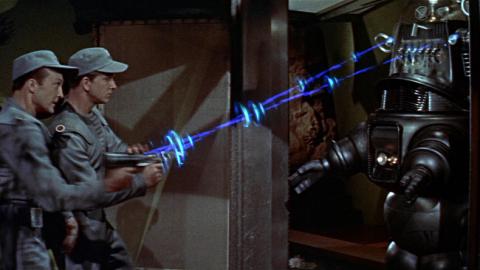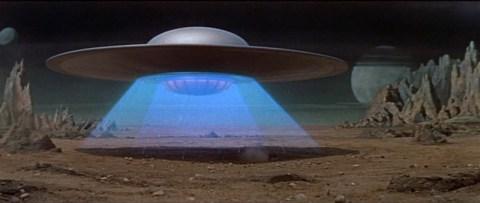
by Steve Habrat
Throughout the 1950s, most of the science fiction films that hit the screen were filmed in black and white and made on shoestring budgets. They were pumped out quickly to capitalize on the sci-fi craze that was running rampant through American audiences. Arguably the best science fiction film of the 1950s is director Fred M. Wilcox’s 1956 effort Forbidden Planet, a pulpy space opera that also acts as a retelling of William Shakespeare’s The Tempest. Appearing as though it has leapt from the pages of one of those “funny books” and featuring an icy electronic score, Forbidden Planet is a film that truly tickles the eyeballs. It is all about the sky-high production values that are almost like staring into a cosmic rainbow, yet Wilcox doesn’t lean solely on the visuals. Forbidden Planet is also a cautionary tale about rapid technological advancement and those advancements spinning horribly out of control to the point of total annihilation. It perfectly reflects the anxiety and the tension of the 1950s, an era that saw the beginning of the Space Race, a general boom in technology, and the hydrogen bomb.
Forbidden Planet begins in the early 23nd century, with the United Planets Cruiser C57-D a year out from earth and traveling to the planet of Altair. It turns out that the crew of C57-D, led by Commander J.J. Adams (played by Leslie Nielsen), is there to investigate the fate of an expedition crew sent to Altair twenty years earlier. Upon entering orbit, the crew makes contact with Dr. Edward Morbius (played by Walter Pidgeon), who warns the crew not to land on the planet. Commander Adams ignores the warning and proceeds to land anyway. Minutes after touching down, the crew is greeted by Robby the Robot, an extremely intelligent robot who acts as an assistant to Morbius. Robby takes Commander Adams, Lieutenant Jerry Farman (played by Jack Kelly), and Lieutenant “Doc” Ostrow (played by Warren Stevens), to Morbius’ home, where the group is also introduced to his beautiful daughter, Altaira (played by Anne Francis). Morbius explains to the group that an unknown planetary force attacked and killed his crew and then vaporized their ship, the Bellerophon. Morbius then warns the group that they should leave the planet before they meet the same fate. But after equipment aboard C57-D is sabotaged, Commander Adams confronts Morbius about the damage. Morbius reveals that he has been studying an alien race known as the Krell, which mysteriously disappeared 200,000 years earlier, just as they achieved a great scientific breakthrough. As the days pass and the crew works to restore their ship, they discover that the damage may be caused by an invisible and extremely violent life form that watches from the surrounding hills.
Right from the start, director Wilcox works hard to establish a pulpy aesthetic that resembles something out of a comic book. Every color pops and flat out refuses to let you turn away. The environments look absolutely breathtaking, almost like a Technicolor dream made alien through a chirping electronic score that is just perfect. Yet despite all the cosmic color and alien blips, Forbidden Planet never once thinks about winking at the audience. It plays itself completely straight, something that will most certainly catch first time viewers off guard. Once the crew of C57-D lands on Altair, Wilcox is all about letting the viewer get to know the characters and the world around them. We are taken through glowing underground factories and shown all sorts of futuristic devices that do all sorts of wondrous (and dangerous) things. It truly is an immersive experience and not one moon rock is left unturned by the climax. While over half the film is explanation and plot development, the final stretch gives way to some pretty tense action sequences that really zip, bang, and flash. The less you know about the finale, the better, but just know that it will blow you away and have you wondering just how the filmmakers pulled all those effects off.

In addition to rich set design and the unforgettable score, Forbidden Planet is also loaded with unforgettable performances. Nielsen, who is mostly remembered for his comedic performances, is spectacular as the brave hero racing to understand the environment around him. We are never treated to a hint of his comedic talents and you can’t help but think that he would have made a great action hero if he had pursued it further. Pidgeon is commanding as our mysterious guide through this alien land. There is an angle of menace to his character and the heavy weight of tragedy is resting on his shoulders. Stevens is solid as Nielsen’s sidekick, “Doc” Ostrow, who is tasked with trying to understand the alien life form that is prowling around the ship. Francis is perfectly naïve and beautiful as Morbius’ sheltered daughter, Altaira, who is enamored by the “Earthmen” that keep visiting her home. Kelly is charismatic as the lovesick Farman, who desperately tries to cuddle up to Altaira. Earl Holliman also turns up in a supporting role as C57-D’s cook, who is desperate for another bottle of bourbon. Last but certainly not least is Robby the Robot, probably the most iconic character from Forbidden Planet. He may not have all that much to do besides moving heavy pieces of equipment with one hand or making 60 gallons of bourbon, but he is given plenty of personality through the voice of Marvin Miller, who elevates the walking pile of spinning parts into a real charmer.
Like most of the science fiction films of the 1950s, Forbidden Planet has quite a bit on its mind. You get the impression that Wilcox and his screenwriters, Cyril Hume, Irving Block, and Allen Adler, are reflecting upon the detonation of the atomic bomb and the rapid advancements that were being made in the Atomic Age. There is fear here that these great powers that America was experimenting with may also be our downfall. If you ignore the atomic fears that creep through the film, you’ll still notice that the film is incredibly influential. In addition to the breakthrough electronic score, Star Trek creator Gene Roddenberry has said that Forbidden Planet was one of his major inspirations for the classic show. The film is also mentioned in The Rocky Horror Picture Show during the opening song. Overall, brimming with personality, wit, thrills, chills, and charm, Forbidden Planet is an irresistible and massively influential entry into the science fiction genre. It has powerful performances, extraordinary set design, and special effects that continue to astonish to this very day. It is a deep and thoughtful journey through space that you will want to take again and again.
Grade: A+
Forbidden Planet is available on Blu-ray and DVD.
